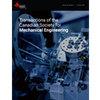VARTM process of composites using double-bag air cushion method
IF 1
4区 工程技术
Q4 ENGINEERING, MECHANICAL
Transactions of The Canadian Society for Mechanical Engineering
Pub Date : 2022-11-02
DOI:10.1139/tcsme-2022-0086
引用次数: 1
Abstract
This article introduced the double-bag air cushion method (DBACM) as an economical and efficient manufacturing process of polymer composites associated with the vacuum-assisted resin transfer molding (VARTM) process. The method utilizes an improved double-bag along with several air cushions to create distribution channels for enhancing the resin flow during infusion. Experimental evaluation on resin infusion behavior and mechanical properties, including ultimate strength, void content, surface finish, and thickness uniformity, is performed for composites reinforced with both jute fibers and glass fibers. Results showed that the DBACM reduces the infusion time by more than 26.0% as compared with traditional VARTM. The difference in ultimate strength of the part between the DBACM and the VARTM is about 2.9%–3.9%. The void content of the E-glass composites is 1.3%–1.5% due to the few fissure-like microvoids, whereas the void content of the jute composites is high, about 2.4%–4.0%, because of the sparse spherical macrovoids. Additionally, there are no major differences in surface finish and thickness uniformity between the parts fabricated by DBACM and by conventional VARTM.复合材料的VARTM工艺双袋气垫法
本文介绍了双袋气垫法(DBACM)作为一种与真空辅助树脂转移模塑(VARTM)工艺相结合的经济高效的聚合物复合材料制造工艺。该方法利用改进的双袋和几个气垫来创建分配通道,以增强灌注过程中的树脂流动。对黄麻纤维和玻璃纤维增强复合材料的树脂灌注行为和力学性能,包括极限强度、空隙率、表面光洁度和厚度均匀性进行了实验评估。结果表明,与传统的VARTM相比,DBACM减少了26.0%以上的输液时间。DBACM和VARTM之间的零件极限强度差异约为2.9%–3.9%。E-玻璃复合材料的孔隙含量为1.3%–1.5%,这是由于很少有裂隙状微孔,而黄麻复合材料的空隙率较高,约为2.4%–4.0%,这是因为稀疏的球形大孔隙。此外,DBACM和传统VARTM制造的零件在表面光洁度和厚度均匀性方面没有重大差异。
本文章由计算机程序翻译,如有差异,请以英文原文为准。
求助全文
约1分钟内获得全文
求助全文
来源期刊
CiteScore
2.30
自引率
0.00%
发文量
53
审稿时长
5 months
期刊介绍:
Published since 1972, Transactions of the Canadian Society for Mechanical Engineering is a quarterly journal that publishes comprehensive research articles and notes in the broad field of mechanical engineering. New advances in energy systems, biomechanics, engineering analysis and design, environmental engineering, materials technology, advanced manufacturing, mechatronics, MEMS, nanotechnology, thermo-fluids engineering, and transportation systems are featured.

 求助内容:
求助内容: 应助结果提醒方式:
应助结果提醒方式:


